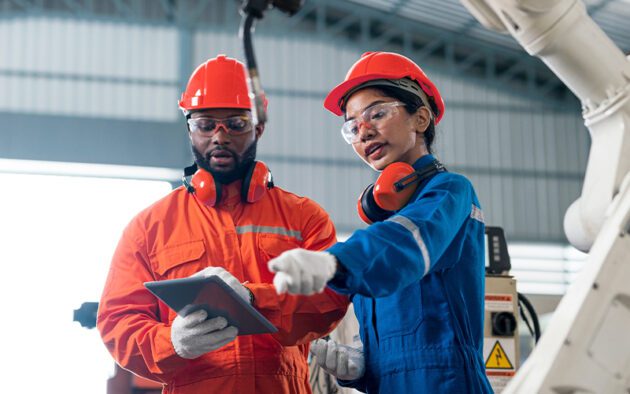Manufacturing is one of the most important industries in the world and our culture. When you think of the word “work,” you probably imagine workers on an assembly line like in the classic cartoons and TV shows where Donald Duck, Charlie Chaplin, and Lucille Ball worked (or were comically overwhelmed) on a production line.
The manufacturing industry has changed immensely since then, especially in the last 30 years, with the introduction of workforce software that changes how we communicate and automation that changes the way we work. Where hands and fingers once did the intricate manufacturing work, now it’s often complex machines guided by human touch.
It would be easy to assume these innovations have only bolstered manufacturing, but the extra training and technical expertise workers need to thrive in a more automated environment also creates barriers to hiring. Along with increasing retirements from older generations of employees, it has contributed to a massive shortage of skilled labour.
How massive? Current estimates suggest there is a global shortage of manufacturing workers, which will create a job gap of 2.1 million positions by 2030.
Where have all these workers gone? And how can companies entice them back to manufacturing with the help of comprehensive workforce solutions and employee management software that proves it’s one of the steadiest, most exciting industries around?
The Impact of Negative Perceptions on Modern Manufacturing
Technology has transformed the manufacturing industry like no other. Whilst education, healthcare, and retail have looked pretty much the same for centuries, manufacturing seems to get a makeover every generation. Frequent changes to manufacturing processes, from robot arms to the Smart Factory, also make the industry seem far more turbulent than it truly is.
Whilst innovation and automation have affected the industry, manufacturing is far more stable than some may believe. Skilled workers are not only still valued in the smart factories, but they’re also desperately needed. Moreover, after the pandemic exposed weaknesses in the offshoring model, many factories are “reshoring,” moving workforce operations back to the American communities they helped build. The human touch is alive and well in production, and considerable benefits await the workers willing to put in the time and effort.
Gap in Training & Skills
So, why do these shifting perceptions exist? In part, it’s because it’s difficult for the public to form an accurate opinion. The stereotype of factories employing only “unskilled labour” is outdated, inaccurate, and hard to shake. Some still think a college education would only be wasted in manufacturing. That’s simply not true. The massive gap between properly trained and skilled workers and the quality jobs and employers that need them only helps to prove it.
Modern workforce management software platforms (like the WorkForce Suite) can help employers fill these gaps. How? By making training more efficient and impactful, for starters. Studies have found that most organisations implement training either too early or in intervals spaced too far apart, which leads to most workers forgetting the bulk of their training within six months. With workforce technologies that improve communication between employer and employee, training can be done on demand to ensure that workers have all the information they require—and production never needs to slow down.
Improving Employee Experience
Another perceived barrier to manufacturing is the fear people have of being undervalued and seen as “a cog in the machine.” Or having unpleasant workforce experiences with confrontational supervisors.
But the truth is that manufacturing jobs are just like any other, with protocols and support in place to help employees feel valued. This has only been bolstered through innovation. These days, workers can learn and communicate directly through their smartphones. They have more up to date information and better communication channels with their managers. The result is often a more positive workforce experience with greater engagement and less turnover.
Employers might also consider recent data that shows people are increasingly attracted to jobs with rostering flexibility. 79% of workers say they would prefer an employer that values flexibility. And yet, 62% of workers say they don’t see their roster more than a week in advance and 41% can’t swap shifts with other employees. Giving staff more autonomy over their roster to build the work/life balance they desire can help increase job satisfaction and retention.
A Bright Future for Manufacturing
Though the gap between the number of skilled workers and open positions is large, it’s not insurmountable. When manufacturers make the most of workforce management software like the WorkForce Suite, their employees can get the training and skills they need and even enjoy work more along the way. Hopefully, our culture will start to portray a more accurate picture of modern manufacturing, and we’ll see a contemporary version of Lucille Ball on the assembly line. She may still have the mouthful of chocolates to make us laugh, but this time, she’ll be backed by all the workforce software solutions she needs to succeed.
The skilled manufacturing worker isn’t going extinct any time soon. Work life for this “endangered species” of labour is improving as we speak with new technology to support them in their roles, foster efficiency through workforce management software, and provide the essential training they need to thrive.
As always, for both workers and their employers, the right tools make all the difference.
Ready to Learn More?
Peek at our Manufacturing Value Accelerator to see what modern workforce management software can do for your workforce experience. Or sign up for a workforce software demo today.




